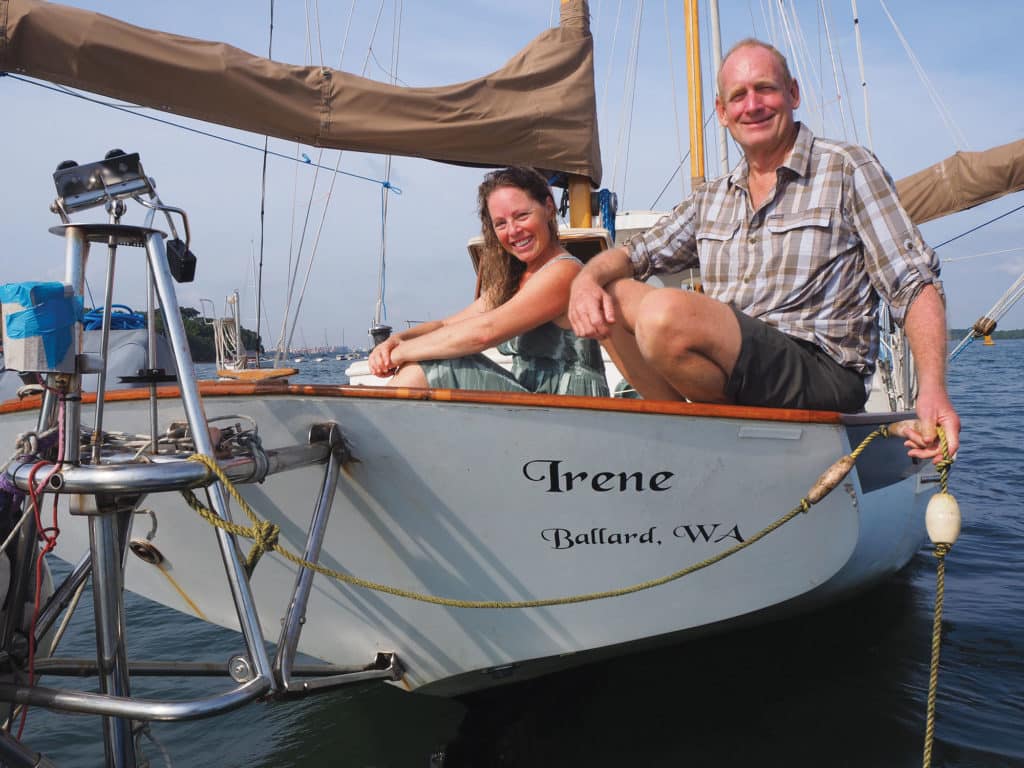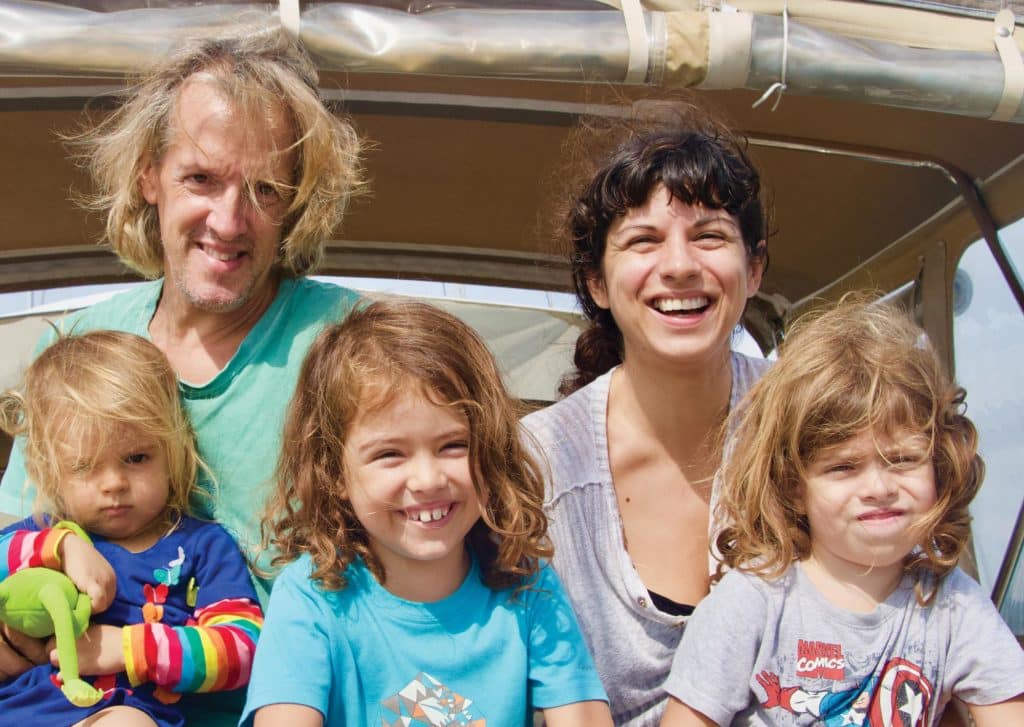
As a liveaboard child in the 1950s, I didn’t get ashore often, so I clearly remember the first time I played musical chairs. It was a strange game, but almost everything the dirt dwellers did struck me as strange back then.
For one thing, we didn’t have stand-alone chairs aboard our 52-foot schooner, just places to sit on deck, in the galley, or around the cockpit. But ashore they had these individual chairs, and when the music stopped, you fought for a seat or you lost. I didn’t like the game. It was exclusionary. Somebody always lost. The game eventually turned all but one of us into a loser.
In March 2020, the music stopped globally for us international circumnavigators. Around the globe, each vessel and its crew had to unexpectedly fight for a chair in an anchorage, if you will. And with out a doubt, some spots were far more preferable than others.
Aboard our ketch, Ganesh, my wife, Carolyn, and I, for instance, lucked out because we had planned on being in Singapore in late 2019 to visit our daughter, Roma Orion, and grandkids Sokù Orion and Tessa Maria.
I always say, “I’d rather be lucky than smart,” primarily because I have such little hope of the latter. Nonetheless, we truly were fortunate. At the time when the music stopped and the cruising curtain fell, we were exactly in the right place at the right time: in COVID-free Singapore, with a mooring and a multiyear visa that allowed us full shore privileges.
Not all globe-trotting cruisers were so lucky.
Take Peter and Ginger Niemann as an example. They circumnavigated from 2006 to 2010 aboard a 47-foot “slutter-rigged” boat (a sloop/cutter they’d converted from a schooner) named Marcy. Then they left Seattle again for circle No. 2 on Irene, a stout 52-foot fiberglass C-Flex ketch, in 2016.
Not wanting to follow their former westabout route, they instead banged a right and transited the Northwest Passage west to east. This is a notoriously rough trip, and they experienced hurricane-force winds in exposed anchorages numerous times. And the timing was tricky. The ice-free window was brief between Canada (to starboard) and the ice pack (to port).
Three-quarters of the way along their passage, they almost turned back at the choke point of Bellot Strait, on the edge of the ice pack, where there was a real danger of either being crushed by or entrapped in the frozen brine. But they persevered and eventually made it through without assistance by laboriously hopscotching through the bergs amid the thickening slush—occasionally almost within touching distance of polar bears.
At the time, theirs was only the 30th American vessel (there have been 267 vessels in total) to transit the Northwest passage, according to the local record keepers.
Then, just to make matters even more challenging, the remnants of tropical hurricanes Irma and Maria forced them to Greenland before heading down to the States. When they finally arrived in chilly Maine, they thought they were in the balmy tropics!
Next stop was the Med. But by early 2020, they were under COVID-19 quarantine in Turkey, though eventually they were allowed to clear out, bound for Batam, Indonesia. Officials there assured them repeatedly that they’d be welcome. Two months and a few thousand miles later, however, when they actually arrived at the Nongsa Marina, Batam officials had changed their minds and allowed them only to briefly reprovision.
Nearby Singapore was their only reasonable port of refuge. But while S’pore would allow them and their vessel to clear in, they would not be able to go ashore because of the pandemic.
They had no choice but to roll with the punches.
As I wrote this, Ginger told me, with a twinkle in her bemused eye, “Gee, Fatty, I really didn’t think this second circumnavigation would involve a 235-day stretch of never being allowed ashore in any country!”
Their hope is to sail home to Seattle via Japan sometime in 2021.
And then there’s the growing family aboard Adamastor.

Decades ago, an artist named James Mostyn was skipping around South America, as artists (and descendants of the Duke of Wellington) tend to do. One drunken night, he hooked up with a bunch of sea gypsies partying on a beach in Central America and unexpectedly fell in love with the cruising community, us included.
An architect by trade, James returned to Jolly Ole England to earn some freedom chips. It took him a number of years to find his dream vessel, the 42-foot Bermudian sloop Adamastor, built in South Africa in 1990.
Hooking up with Jess Lloyd, a fellow artist with a delightfully bubbly personality, they left London for a “two-year cruise nine years ago,” as Jess explains it.
Now, as strong as their combined knowledge of design and art might have been, biology and reproduction weren’t their strong points. Or perhaps they were. Regardless, their oldest daughter is Rocket. She’s as smart as a whip and a budding artist as well. She was born in Mexico, along the way toward the South Pacific. Their son, Indigo, was born in New Zealand. He’s 5. And Autumn, their youngest, just turned 2, but swings around the boat like she’s a teenage trapeze artist instead of a graphic one. (The interior of their vessel is like a floating Louvre of children’s paintings.)
They’d been drifting around in Indonesia for three years and were checking out the Komodo dragons when they got a whiff of a rumor about the approaching COVID-19 pandemic. That’s when Indonesia promptly tossed them out as a result of border closures. Or, more accurately, wouldn’t renew their visa.
They too were at loose ends and in dire straits while near the Singapore Strait. They too needed to stash themselves and their boat for a while to figure out their next move.
Now Singapore isn’t exactly yacht-friendly, but it has a huge commercial-freighter industry, and the ships enjoy a type of “seaman visa” that allows transiting crew to enter the country as long as they don’t get off their vessel.
Thus, at the Changi Sailing Club, where we hang out in Southeast Asia and where we are long-term members, these two unrelated cruising vessels suddenly appeared on moorings like ghost ships.
Both crews were legal-eagle with the local laws and, thus, were in strict quarantine for the first 14 days. They couldn’t leave their vessels, and we couldn’t board. However, once we realized their plight, we started spontaneously delivering them shore treats such as fresh juice, fruits and bakery goods.
In order to do this, we’d just holler from the dinghy, wait for the respective crews to gather in sight on their aft deck, then place our unasked-for-but-greatly-appreciated offerings on their bow with our 12-foot-long boat hook. It was not only legal under Singapore law, but completely COVID-safe as well.
Meanwhile Carolyn and I, not realizing their strict visa limitations, waited patiently for the 14-day quarantine to be up so we could show them the town. (We’re head over heels in love with S’pore and enjoy introducing newcomers to its delights.)
The only problem was that even when the time was up, they couldn’t go ashore. Instead, they were confined to their craft for the duration of their visit. Of course, they and their vessels could leave at any time, but instead they chose to stay because they were safe from COVID and, well, no other country would have them.
Strange, right? Limbo? Purgatory?
The crew on Irene have now been here for over two months. Peter and Ginger haven’t been ashore except to deal with officials. In fact, it’s been nearly five months since they’ve wandered down any beach hand in hand. Plus these high-latitude sailors are Arctic-explorer types. Living in the tropics isn’t their cup of tea. The cabin heater on Irene, ordinarily a top priority, is designed to be the social heart of their happy, stout ship. Cheery cabin heaters, though, aren’t much good directly on the equator.
Ordinarily, their idea of a pleasant day in the cockpit involves snow on deck and icebergs over the bows. And yet here they are—grateful for the resting stop but unable to stretch their legs ashore.
But it is the artists James and Jess and their three-member playpen crew that blows Carolyn and me away. I tried to count those kids from my dinghy once—and stopped when I got to 18 and realized I was counting the same three over and over again because they were popping and repopping out of the hatches like jumping beans.
“Yeah,” James admits wryly, “it is kinda strange to be cruising around and always eyeing the next port to pop out a baby in.”
I mean, a 42-foot sailboat must shrink 10 feet per kid, right? And since the entire family is art-struck, each would, of course, like to lead you by the hand to where their pictures are tacked up on the bulkhead.
Glancing through a porthole, I realized I’d forgotten what it is to see a young child without their face illuminated by the glow of a screen. We watch Rocket and Indigo endlessly play on deck, able to amuse each other seemingly forever. (All under the watchful eye of their careful parents, of course.)
So yeah, we do a lot of rail hanging, and we’ve all become great, if socially distant, friends. Since James, Jess, Autumn, Indigo and Rocket number five souls, we can’t visit them because no private vessel can have more than five people aboard.
However, where there’s a will, there’s a way. Last weekend, Carolyn, Roma, and our two grandkids anchored our dinghy not too far off their portside and sort of allowed the kids to co-party within sight of each other. We also dumped off a ton of old books and used toys from Roma’s house, and a good, if weirdly strange, kiddie time was had by all.
The truth is that the cruising community is adapting to new circumstances and travel restrictions in entirely novel and diverse ways. We all love each other in the sea-gypsy sphere, but we have to be more creative during a pandemic.
For the record, no pint-size crew could possibility be more lovable (or creative) than Rocket, Indigo and Autumn. Now if we could only figure out a way to broach the subject of birth control with their parents!
Cap’n Fatty and Carolyn are still having a ball despite being forced to keep a safe distance in Southeast Asia.








